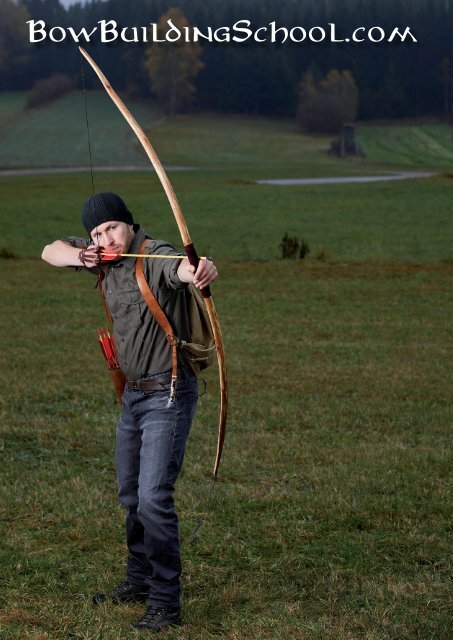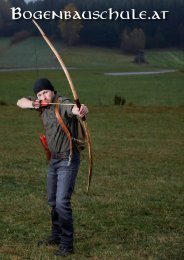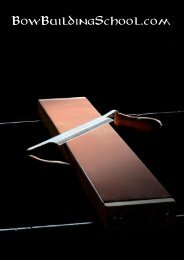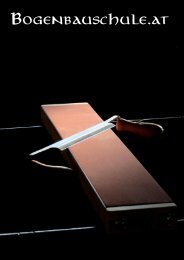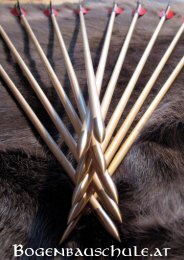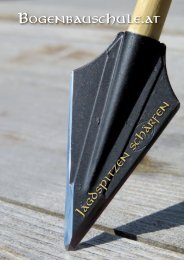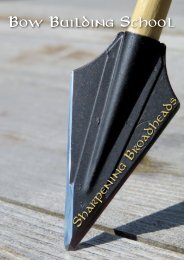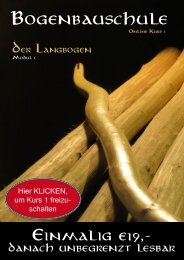You also want an ePaper? Increase the reach of your titles
YUMPU automatically turns print PDFs into web optimized ePapers that Google loves.
BowBuildingSchool.com
Imprint<br />
Publisher and owner:<br />
Matthias Wiltschko<br />
Gross Gundholz 25, 3920 Gross Gerungs, Austria<br />
www.BowBuildingSchool.com<br />
Publisher and media owner takes no legal responsibility or liability.<br />
All rights, copying, distribution and translation rights are with the<br />
owner and publisher.<br />
Text, translation and layout: Matthias Wiltschko<br />
Photos: Rupert Pessl, Matthias Wiltschko<br />
No legal responsibility or liability for injuries and damage to property<br />
of the customer/reader and third parties is taken over by the information<br />
provided and by the objects produced therefrom (eg bows, arrows,<br />
tools . . . ). Each customer/reader is responsible for his/her own safety<br />
and safety in dealing with his/her bows, arrows and tools. It is at the<br />
measure of the customer/reader to assess and avoid dangerous situations<br />
with bows, arrows and tools.
<strong>Shooting</strong> <strong>Selfbows</strong><br />
Every person is unique: physique, muscles, posture, flexibility, eyes, depth<br />
perception, mental attitude . . . We have to find a shooting style that best<br />
suits our disposition.<br />
Maybe you already thought of it when you read the headline, that your<br />
40# selfbow needs a new set of arrows that is even better tuned and<br />
the spine of the shafts is not 35# this time but 36#, because the arrows<br />
have been hitting a little too far to the right. You are already on the right<br />
track and have your bow under control, but there are basic adjustment<br />
screws you need to consider that prevent constant and never-ending<br />
tuning of the arrows and the bow right from the beginning.<br />
It’s no fun if you are constantly questioning your arrows and your bow:<br />
shortening arrows, increasing tip weight, extending<br />
arrows again with foreshafts, then again reducing<br />
tip weight, changing the brace height of the bow,<br />
moving the nock point, changing the anchor point,<br />
changing arm position, adjusting the pressure point<br />
on the bow, changing the pressure point in your hand . . .<br />
Above all, the consideration of the most<br />
important basics should protect you<br />
from dead-tuning your motivation.
There is no tuning and shooting technique panacea, however<br />
the foundation always remains the same. The listed tuning tips<br />
and shooting techniques show the most important aspects that<br />
helped me to shoot more consistently.<br />
and<br />
There are many books written about this topic.<br />
No matter what sources you use, always pay<br />
attention to only change one factor of<br />
your shooting style, your bow or your<br />
arrows at one time and gauge the results.
Instinctive / Intuitive<br />
Paul Comstock searched for the inventor of ‘Instinctive Archery’ and was<br />
able to date this term at around 1934.<br />
With this shooting technique, no aiming aids like the arrow tip or<br />
pins are used on the bow; only the view with both eyes on<br />
the smallest possible target point is applied.<br />
It should be noted that one pin set at hunting distance is not<br />
heretical, but appropriate for a clean kill.<br />
It makes a big difference if you only shoot for fun at<br />
targets or 3D animals, or if the bow and arrow are<br />
actually used as lethal hunting weapons:<br />
The animal has to be killed quickly!
There are no rules for aiming aids on selfbows; everything is allowed to<br />
increase the accuracy of the shot. The arrowhead can be used<br />
to facilitate horizontal aiming or a pin mounted on the handle<br />
can be utilized to mark the exact impact of the arrow at a<br />
certain hunting distance.<br />
Aiming guides provide security. Some people feel<br />
most comfortable in fixed structures and achieve unmatched<br />
performance here. Others need to stay dynamic<br />
and need the possibility to adapt flexibly to new<br />
circumstances to be able to react accordingly.<br />
All aiming aids, the best intuition and the sharpest,<br />
most rigid look at the target are worthless if the<br />
draw is not constant and you shoot with poorly<br />
matched and tuned arrows.
Paul Comstock:<br />
“Sometime around 1934 the term, ‘instinctive‘ was created not because<br />
it appeared in print at that time, but because that marked the very beginning<br />
of the National Field Archery Association, which grew bigger<br />
and bigger in the following years and promoted ‘Instinctive <strong>Shooting</strong>’<br />
heavily -- at least until fiberglass bows appeared.<br />
One-time NFAA secretary John L. Yount in 1974 wrote a history of<br />
the group’s origins, which I found online. A goal, Yount wrote, “was to<br />
promote a shooting style, ‘Instinctive’ that would greatly increase the<br />
number of archers.”<br />
If we think a minute about what he wrote, he is literally saying the ‘Instinctive<br />
Archery’ concept would ATTRACT lots of new archers. He did<br />
not say ‘Instinctive <strong>Shooting</strong>’ would make the new archers accurate<br />
shots. ‘Instinctive’ seems to promise accurate shooting without having<br />
to do a lot of thinking.<br />
The creation of the term was absolutely a reaction to and an attack on<br />
the methods used by the National Archery Association, whose members<br />
included very accurate and deadly bowhunters such as Pat Chambers<br />
and Cassius Styles.<br />
The methods of the NAA would have been confusing for novices for<br />
several reasons. For example, no one could become proficient at NAA<br />
methods without directly interacting with NAA members, including those<br />
who were archery coaches. Not everyone<br />
could do that.<br />
Also, there were competing schools of thought in the NAA, such as ‘relaxed’<br />
vs. ‘nonrelaxed’ which were competing ideas in the 1930s. Even<br />
those terms are confusing, because ‘relaxed‘ in reality referred only to<br />
a bent elbow of the bow arm, and ‘nonrelaxed‘ referred only to the bow<br />
arm extended and locked at the elbow.<br />
Unless archers were directly exposed to the NAA, trying to figure out<br />
NAA methods was a mess, a real headache . . . a pain in ass! Yount<br />
and others wanted to start over with something new, and ‘Instinctive’<br />
was the best thing they could think of.
The Pillars of Selfbow Tuning<br />
1 - Long Bows<br />
Man-sized or longer bows store more energy than short bows due to<br />
the lower string angle. The long limbs act like stabilizers and make<br />
constant shooting easier. Even with a slightly shorter draw, the stored<br />
energy and trajectory change only minimally. Short bows are more nervous<br />
and more difficult to control. Due to the disproportionate increase<br />
of the draw weight towards the end, even a small change in the draw<br />
length has a strong impact on the vertical hit accuracy.
2 - Light-Weight Tips<br />
The ends of the bow must be made as narrow and light as possible to<br />
keep the limb vibration and hand shock low. At the same time, lightweight<br />
tips increase the arrow speed enormously and thereby improve<br />
the vertical hit pattern over long distances.
3 - Light-Weight Bow Strings<br />
The lower the mass of a bowstring, the faster the arrow will be. Too<br />
thick, heavy and tightly twisted strings slow down the arrow speed and<br />
it is more difficult to hit at greater distance.<br />
Does your bow have severe handshock when using thin strings? It<br />
shows you that the tips are too heavy or the main bend of the limbs is<br />
too close to the handle; the outer limb areas do not participate enough<br />
in the overall bend and must be accelerated as dead weight. The energy<br />
required for this is no longer available to the arrow.<br />
The tips, which have too much mass and<br />
the bowstring, which is too tightly twisted<br />
and heavy, slow down the arrow speed<br />
and worsen the shooting comfort.
4 - Brace Height<br />
For selfbows, a brace height of 6 inches measured from the back of the<br />
bow provides a good compromise between accuracy and arrow speed.<br />
If the brace height is too low, the arrow must wind itself more around<br />
the handle when shot. This makes it more difficult to match your set of<br />
arrows and worsens the horizontal hit pattern. The arrow speed only<br />
starts to drop below a brace height of 4 inches. If you design your bow<br />
long and wide enough, you can use a brace height of 8 inches without<br />
overstressing the limbs and causing stringfollow. The arrows are then<br />
slightly slower, but are released more cleanly from the bow.
Arrows<br />
As already mentioned in the foreword, you shouldn’t get lost in the fine<br />
adjustment of the spine value without first taking other fundamental<br />
aspects into account.
Cylindrical, Tapered, Barrelled<br />
The cheapest and easiest to organize shafts are of conventional cylindrical<br />
shape. Tapered shafts whose diameter decreases towards the<br />
end of the nock are released more cleanly from the bow when shot. Barreled<br />
shafts have the largest diameter in the middle or in the front half<br />
of the shaft; these shafts also stabilize faster than cylindrical ones.<br />
In the latter two, however, it is important to pay close attention to the<br />
end at which the shaft is shortened, otherwise they have different mass<br />
distribution and spine.<br />
Why do I only use cylindrical shafts? I have hundreds of 5/16 and 11/32<br />
nocks in stock, but tapered and barreled shafts are 1/4 or 9/32 inches<br />
in diameter at the back end.<br />
Plastic nocks are really cheap and not a valid reason for preferring to<br />
use cylindrical shafts. When selecting my shafts, I don’t want to have<br />
to commit to only one manufacturer, on whom the quality of my arrow<br />
flight solely depends. I always try to use standardized products with my<br />
arrows to ensure reproducibility for myself and my readers.
Arrow Length<br />
Why talk about the length now when the arrows are not even finished?<br />
If you shorten your arrows exactly to your draw length, the spine value<br />
and the tip weight have to be meticulously adjusted to achieve a constant<br />
hit pattern. The shorter the arrow, the higher the bending stiffness,<br />
i.e. the spine value.<br />
So it may be that you need arrows with a spine of 36# for your 40# selfbow,<br />
so that they can wind themselves cleanly around the handle when<br />
shot. Short shafts with a spine of 40# would be too stiff and would hit a<br />
target to the left of a right-handed shooter or hit hard on the side of the<br />
bow’s handle area.
If you leave your arrows 4 inches longer than your draw length, then a<br />
large part of the shaft is in front of the bow’s back right from the start of<br />
the shot: this part of the arrow is already aimed at the target and stabilizes<br />
the flight.<br />
The longer the shaft, the lower the bending stiffness, the spine. So you<br />
could use 32” shafts with a spine of 40# on your 40#@28” selfbow and<br />
the arrows hit exactly in the middle of the target.
Tip Weight<br />
The higher the mass of the arrow tip, the more flexible the shaft becomes:<br />
the spine value is therefore reduced. If the arrows hit too far<br />
to the left (right-handed shooters), increasing the tip weight can move<br />
them to the center.<br />
If the shafts are too flexible and the arrows always move to the right,<br />
the reduction of the tip weight increases the bending stiffness, the spine<br />
value and moves the hit pattern to the left.
So before you start shortening long shafts because they have too little<br />
spine for the draw weight of your bow, reduce the tip weight from<br />
100grain to 70grain and check the arrow flight again.
Feathers/Fletches<br />
The longer or higher the feathers are, the faster the arrow stabilizes in<br />
flight, but the faster it loses speed.<br />
The fletches can be glued slightly twisted onto the shafts to increase<br />
rotation and stabilization. However, the fletches must be glued absolutely<br />
evenly, otherwise the hit pattern deteriorates again. I never use<br />
twisted feathers on my arrows because the shafts must fit the bow well<br />
from the start and have to be matched to each other so that every one<br />
of them flies straight even without fletches.<br />
Long fletches also require an increase of the bow’s brace height, otherwise<br />
they would always rub against the handle when you nock them.<br />
Very high feathers are thin and sensitive. High fletching can also create<br />
a whistling sound which will scare off wild animals; 3D foam animals<br />
are unimpressed by that sound.
The stabilization windings under the nock look nice, but they are poisonous<br />
for the arrow flight. The narrow turns of the glue soaked thread<br />
have a high mass and shift the center of gravity further backwards.<br />
Even without windings, I have never broken a selfnock.
In the case of self-cut feathers with long ends, care should be taken to<br />
ensure a greater distance to the nock of the arrow, otherwise they will<br />
rub against the fingers.<br />
After years of testing, I realized that for my shooting style and the shafts<br />
I used, straight glued-on 4” shield fletches represent the best compromise<br />
between accuracy and arrow speed.
Colors<br />
The brighter and more visible the fletches, nocks and shafts are, the<br />
better. This is the only way your brain can quickly grasp the arrow flight<br />
and make fine adjustments for the next shot.
Nock Point<br />
If the arrow is exactly horizontal or at right angles to the bowstring at<br />
brace height, then it will hit the back of your hand or the arrow rest hard<br />
when being shot.<br />
Move the nock point up a little and the problem is solved. This also<br />
eliminates “riding”, the up-and-down movement of the arrow in flight.
<strong>Shooting</strong> Sequence
After stringing a selfbow it MUST be<br />
warmed up carefully. Slowly, the bowstring<br />
is pulled in several moves until<br />
you reach the full draw length. A selfbow<br />
should never be brought to full draw immediately,<br />
or be pulled wildly and hastily<br />
to be warmed up.
With thumb and forefinger,<br />
an arrow is pulled<br />
out of the quiver held<br />
by the nock and . . .
. . . then the arrow’s tip is<br />
guided forward UNDER<br />
the bowstring along the<br />
back of the hand or the<br />
arrow rest.
As the nock approaches the<br />
bowstring, move it between<br />
your index and middle finger<br />
and you can instantly nock<br />
the arrow: you are ready for<br />
the shot immediately.
With your thumb you now<br />
close the index and middle<br />
finger and thus form the<br />
snap link grip.<br />
The string rests exactly<br />
in the first finger joint.
Are you skeptical that you cannot<br />
release the string properly with this<br />
type of grip?<br />
Since the thumb forms the lock and<br />
the string lies in the first finger joint,<br />
the index and middle finger are<br />
loose and under minimal tension.<br />
As soon as you relax your thumb,<br />
the string will snap over your loose<br />
fingers and the release can no longer<br />
be disturbed by a cramp.<br />
With this method you achieve<br />
a more constant release and a<br />
smoother arrow flight.
The snap link grip allows you to relax your wrist and ensures that you do<br />
not kink the string or pull it away sideways from the bow.<br />
Tab or glove?<br />
I have been using the<br />
thickest shooting glove I<br />
could get since 2007. Thin<br />
strings do not cut deep<br />
into the leather and glide<br />
faster over the smooth<br />
surface.
The pressure point in the hand<br />
should be close to the root of<br />
the thumb; this prevents you<br />
from twisting the bow and the<br />
limbs are evenly stressed.<br />
Also make sure your elbow<br />
is facing outwards. There will<br />
be a little bend in your elbow,<br />
but always try to keep it at the<br />
same degree.
Here the handle of the bow<br />
rests in the entire palm and<br />
the wrist is bent upwards. If<br />
your bow is too strong, this<br />
might be the only posture for<br />
you to shoot it. Nevertheless,<br />
try to shift the pressure point<br />
to the root of the thumb.<br />
The elbow is pointing down; it<br />
is locked in and the bowstring<br />
grazes the forearm with every<br />
shot. Try to let the elbow face<br />
outwards.
When the bow is brought upwards,<br />
it is pulled to half its<br />
draw length.<br />
Your eyes and the arrow are<br />
facing at the target . . .
. . . Now the bow is drawn to the anchor<br />
point, with the last inches of the draw performed<br />
very slowly.
To ensure a constant draw<br />
length, it helps to determine<br />
the anchor point of<br />
the string directly above<br />
the eye.<br />
Of course you can also<br />
choose your cheek as<br />
an anchor point.
Visualize how your back tension builds up in one line with the arrow<br />
and the target as you draw.<br />
As soon as you reach<br />
your anchor point, the<br />
string is released. The<br />
draw hand is pulled<br />
back to the ear and you<br />
remain in this position<br />
until the arrow hits.


